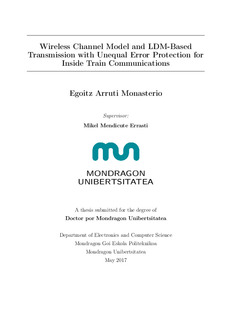
Ikusi/
Izenburua
Wireless Channel Model and LDM-Based Transmission with Unequal Error Protection for Inside Train CommunicationsEgilea
Zuzendaria(k)
Irakurtze Data
2017-07-19Argitalpen data
2017Dokumentu-mota
Doktore tesiaDoktore tesiaHizkuntza
IngelesaEskubideak
© Egoitz Arruti MonasterioSarbidea
Sarbide irekiaArgitaratzailearen bertsioa
https://doi.org/10.48764/t3ms-3m83Argitaratzailea
Mondragon Unibertsitatea. Goi Eskola PoliteknikoaGako-hitzak
ODS 9 Industria, innovación e infraestructuraLaburpena
Although the deployment of wireless systems is widespread, there are still sectors where they are not used due to their lack of reliability in comparison to wired systems. Sectors like industry or veh ... [+]
Although the deployment of wireless systems is widespread, there are still sectors where they are not used due to their lack of reliability in comparison to wired systems. Sectors like industry or vehicle communications consider their environment hostile because the wireless signals suffer a lot of interferences. One of such environments is the railway sector, where wiring removal will allow more flexibility for both control and monitoring systems. This thesis analyzes wireless communications inside train cars, aiming at modelling their behavior and at proposing techniques to increase the reliability of the critical signals among train systems, wich can coexist with other lower priority systems. After proposing a novel model of an inside train wireless channel, a transmission system based on Layered Division Multiplexing (LDM) has been proposed which theoretically promises higher capacities than traditional TDM or FDM. This capacity gain is used to provide higher reliability to critical data using Unequal Error Protection (UEP) while maintaining the same bit rate as equivalent TDM or FDM based systems. In the final part of the thesis, simulation results of the proposed LDM system are provided, combined with Alamouti space time coding and different coding rates. Multiantenna extensions of the proposed LDM schemes are also simulated, providing BER and throughput results. These results will be used to shed light about how to reduce BER of an inside train wireless communication system. [-]
Aunque el despliegue de los sistemas inalámbricos está muy extendido, aun hay sectores donde no se utiliza por la poca fiabilidad que proporcionan comparado con los sistemas cableados. Sectores como l ... [+]
Aunque el despliegue de los sistemas inalámbricos está muy extendido, aun hay sectores donde no se utiliza por la poca fiabilidad que proporcionan comparado con los sistemas cableados. Sectores como la industria o las comunicaciones vehiculares consideran el entorno donde trabajan como entorno hostil, debido a que las señales inalámbricas sufren muchas interferencias. Uno de estos entornos es el de las comunicaciones en ferrocarril donde la eliminación de cables permitiría mayor flexibilidad entre los sistemas de control y monitorización. En esta tesis se analiza el canal de comunicación inalámbrico dentro de los trenes, con el objetivo de modelar su comportamiento y proponer técnicas que permitan aumentar la fiabilidad de la información de tipo crítico transmitida entre los sistemas del tren, repercutiendo lo menos posible en otros sistemas de menor prioridad. Tras proponer el modelo de canal inalámbrico dentro del tren, se ha propuesto un sistema de transmisión basado en Layered Division Multiplexing (LDM) que analizándolo teóricamente promete mayores capacidades que los tradicionales TDM o FDM. Esta capacidad se utilizará para obtener mayor redundancia de los datos críticos usando Unequal Error Protection (UEP) manteniendo la misma tasa de transferencia bits que los sistemas basados en TDM/FDM. En la parte final de la tesis, se obtienen resultados de las simulaciones realizadas con el sistema LDM propuesto, combinada con codificación espacio temporal como Alamouti y diferentes ratios de codificación. También se han simulado configuraciones multiantena obteniendo resultados de BER y throughput. Estos resultados servirán para arrojar luz sobre cómo reducir el BER en las comunicaciones inalámbricas dentro de los trenes. [-]
Haririk gabeko sistemak oso hedatuak dauden arren oraindik erabiltzen ez dituen sektoreak badaude ematen duten fidagarritasuna txikia delako kableatutako sistemekin alderatuz. Industria bezalako sekto ... [+]
Haririk gabeko sistemak oso hedatuak dauden arren oraindik erabiltzen ez dituen sektoreak badaude ematen duten fidagarritasuna txikia delako kableatutako sistemekin alderatuz. Industria bezalako sektoreek edo ibilgailuetako komunikazioek lan egiten duten ingurua oso zaratatsua izaten da eta seinaleek interferentzia asko jasaten dituzte. Tesi honetan tren barruko haririk gabeko komunikazio kanala aztertzen da, bere portaera aztertu eta modelatzeko asmotan. Jakintza honekin zein teknika izan daitekeen erabilgarriak aztertuko da datuen fidagarritasuna handitzeko helburuarekin, lehentasun gutxiago duten sistemetan eragin txikiena izanik. Modeloa atera ondoren proposatu den transmisio sistema Layered Division Multiplexing (LDM) izan da, non azterketa teorikoek TDM edo FDM sistemek baino kapazitate gehiago dutela frogatzen dute. Kapazitate hau sistemaren datu kritikoei erredundantzia gehiago emateko erabiliko da Unequal Error Protection (UEP) erabiliz, TDM/FDM sistemetan bidaltzen den bit tasa kopurua mantenduz. Tesiaren azken partean, proposatutako LDM sistemaren simulazio emaitzak ematen dira, Alamouti espazio denbora kodifikazioarekin konbinatuak eta kodigo ratio desberdinekin. Antena anitzezko konfigurazioak ere simulatu dira BER eta throughput emaitzak lortuz. Emaitza hauek haririk gabeko tren barruko komunikazioetan BER-a nola gutxitu daitekeen jakiten lagunduko digute. [-]
Bildumak
- Tesiak - Ingeniaritza [243]




















